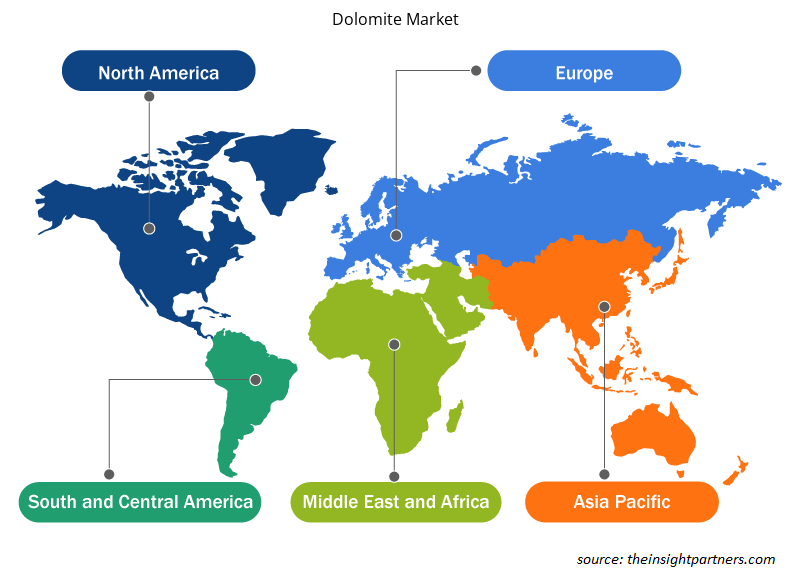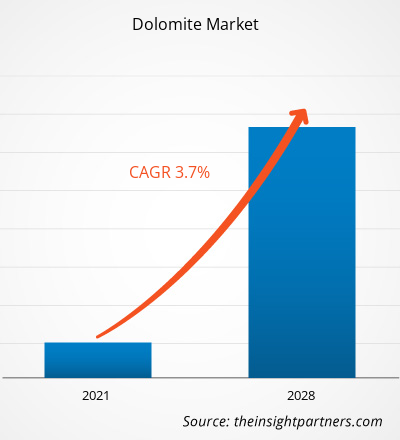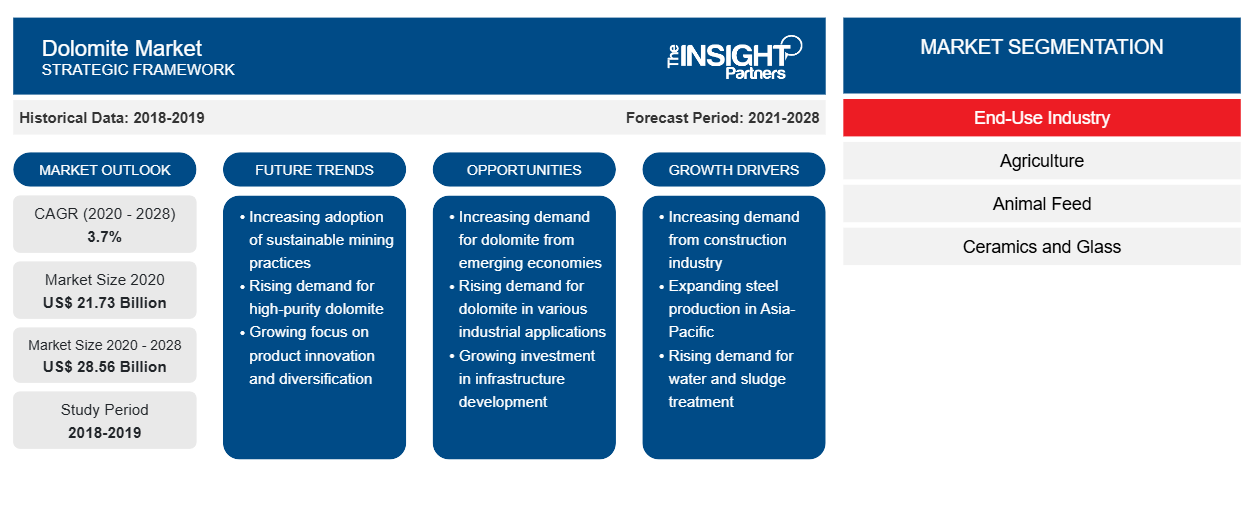Si prevede che il mercato della dolomite crescerà da 21.727,97 milioni di dollari nel 2020 a 28.558,14 milioni di dollari entro il 2028; si prevede una crescita a un CAGR del 3,7% nel periodo 2021-2028.
La dolomite è un materiale importante per le industrie delle ferroleghe ed è ampiamente utilizzata negli impianti siderurgici. Ha anche un'applicazione fondamentale nel settore agricolo grazie alla sua capacità di agire come ammendante del terreno e di bilanciare il pH del terreno. Petrolio e gas, prodotti chimici, gomma, estrazione mineraria e metalli, trattamento delle acque, prodotti farmaceutici e cosmetici sono tra gli altri importanti utenti finali di questa sostanza. Poiché queste industrie stanno assistendo a una crescita considerevole, soprattutto nelle economie in via di sviluppo, anche la domanda di dolomite è in continua crescita. Tuttavia, gli effetti negativi delle attività minerarie sull'ambiente rimangono una preoccupazione per i produttori di dolomite.
Nel 2020, l'Asia Pacifica ha detenuto la quota di fatturato più grande del mercato globale della dolomite . La rapida crescita dell'industrializzazione sta guidando gli investimenti nelle infrastrutture di trasporto in questa regione. Inoltre, un aumento della produzione di refrattari sta spingendo la domanda di dolomite nelle industrie siderurgiche dell'Asia Pacifica. La regione ospita le maggiori economie come Cina e India, che sono tra i maggiori consumatori di refrattari al mondo. La Cina è un importante produttore di acciaio al mondo, mentre l'India sta assistendo a una crescita esponenziale delle infrastrutture. Pertanto, questi fattori stanno offrendo diverse opportunità di crescita per gli operatori del mercato della dolomite nella regione.
Personalizza questo report in base alle tue esigenze
Riceverai la personalizzazione gratuita di qualsiasi report, comprese parti di questo report, o analisi a livello nazionale, pacchetto dati Excel, oltre a usufruire di grandi offerte e sconti per start-up e università
-
Scopri le principali tendenze di mercato in questo rapporto.Questo campione GRATUITO includerà analisi di dati che spaziano dalle tendenze di mercato alle stime e alle previsioni.
Impatto della pandemia di COVID-19 sul mercato della dolomite
L'attuale pandemia di COVID-19 ha drasticamente alterato lo stato del settore chimico e dei materiali e ha avuto un impatto negativo sulla crescita del mercato minerario della dolomite. L'attuazione di misure per combattere la diffusione del SARS-CoV-2 ha aggravato la situazione. Settori come l'edilizia e la siderurgia sono stati colpiti dall'improvvisa distorsione delle efficienze operative e dalle interruzioni nelle catene del valore attribuibili alla chiusura improvvisa dei confini nazionali e internazionali. Un calo significativo della crescita di diversi settori industriali ha portato a una riduzione della domanda di dolomite. La chiusura delle attività minerarie ha creato una performance produttiva annuale ostacolata. Gli effetti a lungo termine della pandemia di COVID-19 sull'industria mineraria dipenderanno dalla durata dei periodi di blocco e dalla capacità degli operatori del settore di riprendersi. Poiché molti paesi stanno pianificando di riprendere le proprie attività, si prevede che la domanda di dolomite aumenterà a livello globale nei prossimi mesi. Gli operatori del mercato minerario della dolomite si stanno concentrando sulla disponibilità di forniture e manodopera per raggiungere livelli operativi completi.
Approfondimenti di mercato
Ampia gamma di applicazioni della dolomite per alimentare la crescita del mercato della dolomite
La dolomite ha un ampio spettro di applicazioni nei settori degli utenti finali come edilizia, ferro e acciaio, ferroleghe, ceramica e vetro, agricoltura e mangimi per animali. La sua preferenza e adozione nei settori dipende dal grado della roccia. La dolomite è una sostanza comunemente usata nel settore delle costruzioni per la sua durezza e densità. Nel settore del ferro e dell'acciaio, la dolomite è usata in tre forme: dolomite grezza, dolomite calcinata e dolomite sinterizzata. La dolomite è usata per la neutralizzazione acida nei settori chimici e nei progetti di ripristino dei corsi d'acqua. È anche usata come fonte di magnesia (MgO), un additivo per mangimi per bestiame. La dolomite è usata nella produzione di vetri per auto, vetri da costruzione, fibra di vetro, ecc. Quindi, con la crescita di vari settori degli utenti finali, come edilizia, ferro e acciaio, ceramica e vetro, anche la domanda di dolomite è in crescita.
Approfondimenti sul settore dell'uso finale
In base al settore di utilizzo finale, il mercato globale della dolomite è segmentato in agricoltura, mangimi per animali, ceramica e vetro, ferro e acciaio, edilizia e altri. Il segmento del ferro e dell'acciaio ha detenuto la quota maggiore del mercato nel 2020. L'industria del ferro e dell'acciaio è fortemente guidata dalla crescita di segmenti come difesa, ingegneria pesante, energia ed edilizia. La domanda sempre crescente da parte di questi settori dovuta alla rapida urbanizzazione e industrializzazione, soprattutto nelle regioni in via di sviluppo come Asia Pacifico e America meridionale e centrale, è un fattore importante che contribuisce all'elevata domanda di dolomite nel mondo, che sta stimolando la crescita del mercato.
Tra i principali attori del mercato globale della dolomite figurano Beihai Group; Calcinor; Essel Mining & Industries Limited; JFE GROUP; INCA MINING; LHOIST GROUP; Sibelco; RHI Magnesita GmbH; Arihant Min chem e Omya AG.
Approfondimenti regionali sul mercato delle Dolomiti
Le tendenze regionali e i fattori che influenzano il mercato della dolomite durante il periodo di previsione sono stati ampiamente spiegati dagli analisti di Insight Partners. Questa sezione discute anche i segmenti e la geografia del mercato della dolomite in Nord America, Europa, Asia Pacifico, Medio Oriente e Africa, e Sud e Centro America.

- Ottieni i dati specifici regionali per il mercato delle dolomiti
Ambito del rapporto di mercato sulle dolomiti
| Attributo del report | Dettagli |
|---|---|
| Dimensioni del mercato nel 2020 | 21,73 miliardi di dollari USA |
| Dimensioni del mercato entro il 2028 | 28,56 miliardi di dollari USA |
| CAGR globale (2020 - 2028) | 3,7% |
| Dati storici | 2018-2019 |
| Periodo di previsione | 2021-2028 |
| Segmenti coperti |
Per settore di utilizzo finale
|
| Regioni e Paesi coperti |
America del Nord
|
| Leader di mercato e profili aziendali chiave |
|
Densità degli attori del mercato dolomitico: comprendere il suo impatto sulle dinamiche aziendali
Il mercato Dolomite Market sta crescendo rapidamente, spinto dalla crescente domanda degli utenti finali dovuta a fattori quali l'evoluzione delle preferenze dei consumatori, i progressi tecnologici e una maggiore consapevolezza dei benefici del prodotto. Con l'aumento della domanda, le aziende stanno ampliando le loro offerte, innovando per soddisfare le esigenze dei consumatori e capitalizzando sulle tendenze emergenti, il che alimenta ulteriormente la crescita del mercato.
La densità degli operatori di mercato si riferisce alla distribuzione di aziende o società che operano in un particolare mercato o settore. Indica quanti concorrenti (operatori di mercato) sono presenti in un dato spazio di mercato in relazione alle sue dimensioni o al valore di mercato totale.
Le principali aziende che operano nel mercato delle Dolomiti sono:
- Gruppo Beihai
- Calcinore
- Essel Mining & Industries Limited
- GRUPPO JFE
- ATTIVITÀ MINERARIA INCA
Disclaimer : le aziende elencate sopra non sono classificate secondo un ordine particolare.

- Ottieni la panoramica dei principali attori chiave del mercato Dolomite
Segnala i riflettori
- Tendenze progressive del settore nel mercato della dolomite per aiutare gli operatori a sviluppare strategie efficaci a lungo termine
- Strategie di crescita aziendale adottate dai mercati sviluppati e in via di sviluppo
- Analisi quantitativa del mercato della dolomite dal 2019 al 2028
- Stima della domanda globale di dolomite
- Analisi delle cinque forze di Porter per illustrare l'efficacia di acquirenti e fornitori nel settore
- Sviluppi recenti per comprendere lo scenario competitivo del mercato
- Tendenze e prospettive del mercato nonché fattori che regolano la crescita del mercato della dolomite
- Assistenza nel processo decisionale evidenziando le strategie di mercato che sostengono l'interesse commerciale, portando alla crescita del mercato
- Dimensioni del mercato della dolomite nei vari nodi
- Panoramica dettagliata del mercato e segmentazione, e dinamiche del settore della dolomite
- Dimensioni del mercato della dolomite in diverse regioni con promettenti opportunità di crescita
Il mercato globale della dolomite è stato segmentato come segue:
Per settore di utilizzo finale
- Agricoltura
- Mangime per animali
- Ceramica e Vetro
- Ferro e acciaio
- Costruzione
- Altri
Profili aziendali
- Gruppo Beihai
- Calcinore
- Essel Mining & Industries Limited
- GRUPPO JFE
- ATTIVITÀ MINERARIA INCA
- GRUPPO LHOIST
- Sibelco
- RHI Magnetista GmbH
- Arihant Min chem
- Omya AG
- Analisi storica (2 anni), anno base, previsione (7 anni) con CAGR
- Analisi PEST e SWOT
- Valore/volume delle dimensioni del mercato - Globale, Regionale, Nazionale
- Industria e panorama competitivo
- Set di dati Excel
Report recenti
Testimonianze
Motivo dell'acquisto
- Processo decisionale informato
- Comprensione delle dinamiche di mercato
- Analisi competitiva
- Analisi dei clienti
- Previsioni di mercato
- Mitigazione del rischio
- Pianificazione strategica
- Giustificazione degli investimenti
- Identificazione dei mercati emergenti
- Miglioramento delle strategie di marketing
- Aumento dell'efficienza operativa
- Allineamento alle tendenze normative























 Ottieni un campione gratuito per - Mercato delle Dolomiti
Ottieni un campione gratuito per - Mercato delle Dolomiti